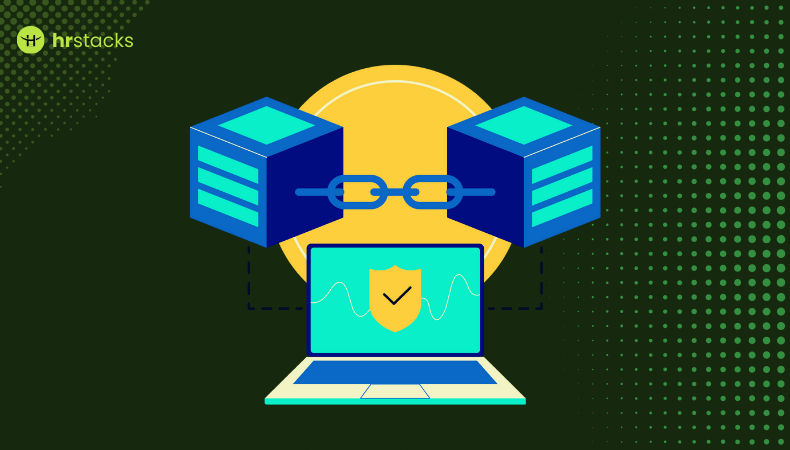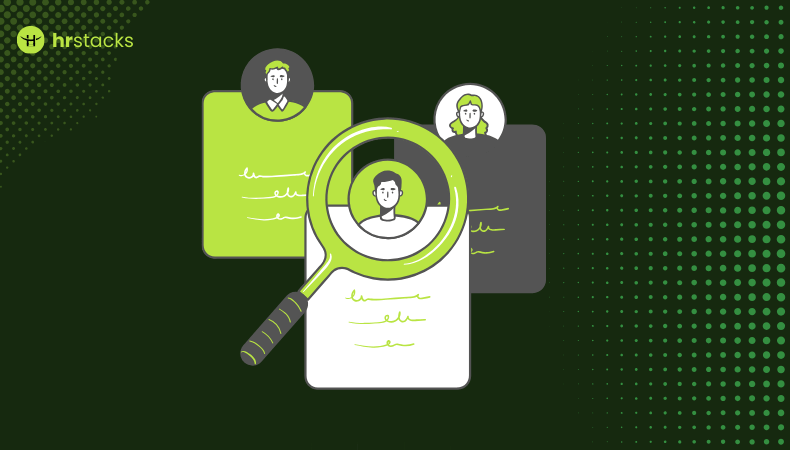Every organisation keeps a surprisingly large file on its employees, from payroll numbers and bank details to addresses, medical histories, and even notes on behaviour. It’s highly personal, and in the wrong hands, deeply risky. Yet most of it still sits on centralised servers, prime targets for hackers or anyone with bad intentions.
This isn’t some abstract “what if” scenario. Payroll providers have been hacked, HR platforms have leaked sensitive files, and workers have woken up to find their personal details circulating online. Despite this, many companies still cling to clunky, outdated systems to hold and pass around that information.
Blockchain flips the script on data security. Instead of trusting one central database to keep everything safe, it spreads trust and the data itself across a whole network. That shift changes how records are stored, verified, and protected from tampering.
In this piece, we’ll unpack how blockchain works in an HR setting, where it can realistically solve problems, and whether it lives up to the buzz.
What Is Blockchain?
At its simplest, blockchain is a digital ledger, a series of “blocks” of data linked together in order. Each block contains the data itself, a timestamp, and a unique fingerprint of the block before it. To change anything, you’d have to rewrite every block after it and get the entire network to sign off. In practice, that’s nearly impossible.
The key difference? Blockchain is distributed. Everyone on the network holds a copy of the ledger, and all copies update in sync. There’s no single vault to break into, and no single gatekeeper who can quietly change the records.
Why It Works?
Here’s why blockchain’s design gives it an edge over traditional databases.
- No single point of trust: By spreading the ledger across many computers, blockchain removes the one “all-powerful” record keeper, and with it, a major tampering risk.
- You can’t quietly rewrite history: Once a block is added, it’s locked in. Changing history would need rewriting everything and getting everyone’s approval, not a small ask.
- No middlemen slowing things down: Blockchain lets you send money, data, or contracts directly, no banks, brokers, or drawn-out approvals in the middle.
- Smart contracts act like self-executing agreements: when the agreed conditions are met, say a shipment is delivered, the contract triggers itself. No chasing signatures or waiting on a third party.
Where It’s Actually Used?
- Cryptocurrency: Bitcoin is the poster child; each transaction lives on the blockchain for all to see (and verify).
- Supply chains: Want to know if your coffee bean was farmed ethically? Blockchain stamps each step with a traceable record.
- Healthcare records, digital IDs, voting systems. Secure, verifiable, and harder to fake.
Quick Summary Table
| Feature | What It Means in Human Terms |
| Distributed ledger | Everybody keeps a copy, no single gatekeeper. |
| Immutable history | Once it’s recorded, you can’t sneakily erase or edit it. |
| Trust without trust | No trusted middleman needed, network confirms validity. |
| Smart contracts | Agreements that run themselves when conditions are met. |
Why HR Teams Should Care?
HR teams deal with highly sensitive data, from personal ID to payroll to credentials, and must constantly guard it against errors, fraud, and breaches. Blockchain offers a solution. Its decentralized, encrypted storage makes tampering nearly impossible.
Immutable records, automated verification, and smart contracts streamline hiring, payroll, benefits, and auditing, bringing greater security, efficiency, and trust to HR operations.
Why Employee Data Is So Easy To Compromise?
Employee data is surprisingly easy to compromise for a few straightforward reasons, and it’s not always because of fancy hacker schemes. Here’s how it often falls apart:
- Human error plays a huge role: Report suggests that 88% of all breaches involve human mistakes, from clicking a phishing link to misconfiguring security settings or accidentally emailing the wrong file.
- Phishing and social engineering are persistently effective, as attackers exploit trust, impersonating executives or trusted services. Most employees, even cautious ones, can slip up.
- Weak credentials and poor access controls, easy-to-guess passwords, reuse across platforms, lack of multi-factor authentication, and overly broad access rights open the door wide.
- Misconfiguration and tech gaps, systems deployed with default settings, unpatched software, or poor maintenance practices are low-hanging fruit for breaches.
How Blockchain Changes The Security Game?
Blockchain isn’t a magic shield against all cyber risks, but it does fundamentally change the way data is stored, shared, and verified.
Decentralized Data Storage
Blockchain spreads HR data across multiple nodes instead of housing it in one server. That makes unauthorized tampering or data loss much harder; attackers would need to breach dozens of systems, not just a single vulnerable database.
That means there’s no single weak link for hackers to exploit, a big step up from the “all eggs in one basket” approach.
Immutable Records
Once employee data is entered into a blockchain, it’s locked in. Any attempt to change or delete it sets off red flags across the network.
Every change is permanent and transparent, which makes undetected manipulation, or “creative record‑editing,” virtually impossible.
Why It Matters: Stops hidden edits and keeps HR data trustworthy and accountable.
Enhanced Encryption And Privacy
Every blockchain entry is encrypted and then scattered across the network. Even if an attacker got hold of the data, all they’d see is scrambled code without the keys to unlock it. Plus, permissioned models ensure only authorized parties with the right keys get access.
Why It Matters: Ensures only authorized eyes ever see sensitive HR information.
Smart Contracts For Automation
Smart contracts let HR automate tasks, like payroll or benefits, without human oversight. The contract executes itself when pre-set conditions are met, reducing manual handling, human delays, and potential tampering.
Why It Matters: Eliminates manual delays, reduces errors, and locks in secure HR automation.
Transparent Audit Trails
Every HR action, record updates, access, and verification are logged in a transparent, time‑stamped chain. HR leaders and auditors can instantly trace who did what, when, and how, without trusting a centralized log prone to manipulation.
Why It Matters: Provides a verifiable, tamper-proof log for complete compliance and trust.

What Blockchain In Employee Data Security Looks Like In Practice?
Here’s what blockchain in employee data security looks like in real HR settings, fleshed out with plain language and compelling real-world examples, all backed by reputable sources:
Secure Credential Verification – Workday
Workday has developed Workday Credentials and the WayTo™ mobile app, blockchain-powered tools that allow individuals to store and share verified credentials securely. Employers can immediately confirm qualifications without cumbersome manual checks.
Employee Work History Sharing – IBM Prototype
IBM, in collaboration with Persol Career, designed a permissioned blockchain prototype for storing, verifying, and sharing employee work histories. This enables faster and more secure onboarding by empowering applicants to grant access to verified records.
Enhancing Hiring Integrity & Efficiency – SHRM & Industry Reports
SHRM emphasizes that blockchain could enable reliable “self-sovereign identities,” reducing third-party inaccuracies in candidate verification.
Blockchain-based hiring platform Zinc partnered with SmartRecruiters to integrate verified candidate data into ATS systems, improving data reliability
The Benefits Of Blockchain In Employee Data Security
Here’s a crisp, reader-friendly breakdown of the benefits of using blockchain for employee data security, each point clearly explained and backed by sources:
| Benefit | How It Helps HR |
|---|---|
| Immutable Records | Permanent, tamper-proof logs of employment history and transactions. |
| Smart Contracts | Automates agreements like offer letters, NDAs, and benefits enrollment, reducing admin time. |
| Credential Verification | Instant, trustworthy checks on education, skills, and certifications from verified sources. |
| Data Security | Decentralized storage reduces single points of failure and hacking risks. |
| Faster Onboarding | Verifies identity and documents in minutes instead of days. |
| Global Compliance | Transparent record-keeping helps meet data privacy and labor law requirements worldwide. |
| Reduced Fraud | Makes falsifying resumes or employment history significantly harder. |
| Cost Savings | Cuts expenses tied to manual verification, third-party checks, and paperwork processing. |
Should You Use It?
Blockchain can genuinely improve data security, automate time-consuming processes, and make records more transparent, but it’s no silver bullet.
- Highly sensitive data that needs tamper-proofing,
- Clear pain points like slow verification or demands for auditability,
- Strong tech and legal support to pilot the system,
- Willingness to invest cautiously at first.
Try a focused pilot, like credential verification or smart onboarding, and scale from there. If you’d like, I can help design a pilot framework or ROI checklist tailored to your organization.
Conclusion
Data breaches aren’t a passing storm; they’ve become the norm, especially as employee records grow more complex in today’s global, remote work landscape.
Traditional HR systems struggle because they’re centralized, outdated, and increasingly vulnerable to hacks and human error. Blockchain isn’t a silver bullet, but it’s a tool that deserves attention.
Its decentralized structure and unchangeable audit trails give HR teams a way to lock down sensitive data while enabling trust, privacy, and compliance to move from empty buzzwords to verifiable reality.
Adopting blockchain shouldn’t be about ticking the “innovation” box. It’s about safeguarding the most valuable asset any organisation has, its people and their data. In an era where confidence in data security matters more than ever, blockchain can help you deliver on that promise.










